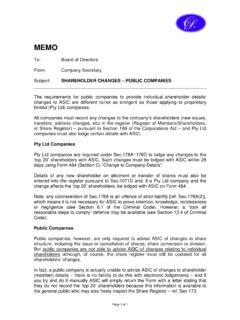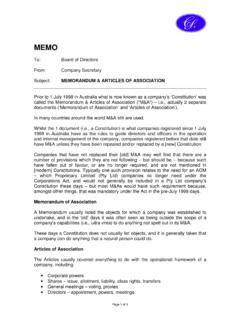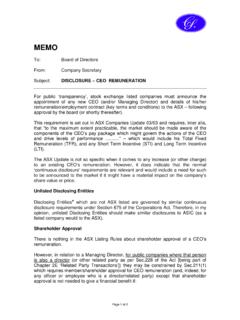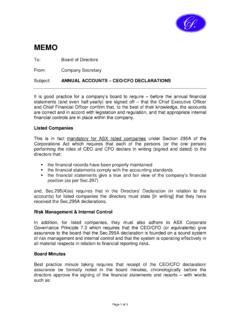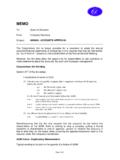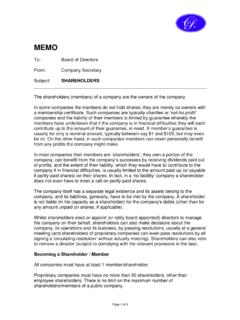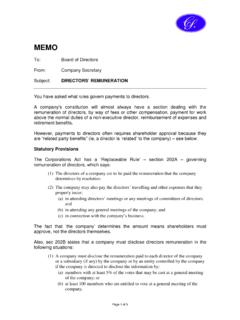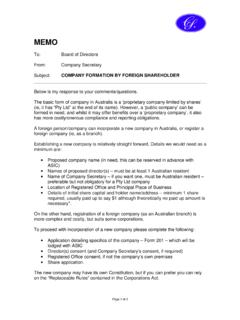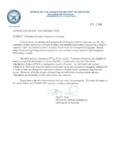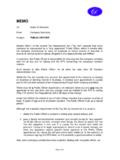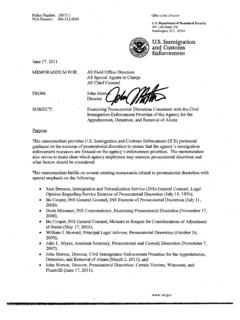Transcription of MEMO - companysecretary.com.au
1 Page 1 of 2 memo To: Board of Directors From: Company Secretary Subject: SHAREHOLDING BY TRUSTS Shares in a company can only be held and registered in the name of (ie, be legally owned by) a real person (singularly or jointly with one or more others) or a body corporate (or similar entity). A shareholder must be a legal entity that has the capacity to own property, sue or be sued. (Note: even minors can hold shares in their own name there is no minimum age.) Shares cannot be held in a name which is not a legal entity, for example: Unincorporated body must be in the name of an office-holder/s Partnership must be in one or more partners names Business name must be in the name of the proprietor (providing it is a legal entity itself) Trust must be in the name of the trustee Superannuation fund must be in the name of the trustee Deceased estate must be in the name of the executor (trustee) Bankrupt must be in the name of the trustee in bankruptcy.
2 However, the underlying beneficiary of the shares may be someone other than the shareholder in whose name they are actually registered. So, the CA recognizes in (3)(b) that a shareholder may create an equitable interest in respect of shares held, including as a trustee, because they are not really the beneficial owner (they are just the legal owner). In those cases where the legal owner is not holding the shares for itself, but rather is a trustee, and the beneficial owner is a trust or superannuation fund, etc, the legal owner (in whose name the shares are registered) must advise the company, under CA (11), within 1 month of share issue or transfer or of becoming a trustee either by noting it on the share application or transfer form, or by separate written advice that it is holding the shares non-beneficially (ie, an equitable interest has been created for the benefit of another party), and the company may, but is not obliged to, record details of the beneficial owner in the share register.
3 CA (9) allows recording of a trust interest in the share register if the company so agrees. However, many company constitutions state that the company will not register or recognise a trust or other equitable or beneficial interest (other than that of the legal owner in whose name the shares are registered) unless required by law to do so. Moreover, under (10) the CA expressly states that no notice of a trust, whether express, implied or constructive, must be entered in Page 2 of 2 the register (one reason being that it could be very inconvenient for a company, and commerce generally, if the company had to take notice of, or be constrained by, a trust or other equitable interest in its shares). So, in summary, noting a trust (beneficial interest) in the share register is only done if the company allows it.
4 Recording of shareholder names in the share register where there is a different beneficial owner usually follows the style Alan Smith <Smith Family Trust A/C> . Also, any change in trustee (of a particular trust) would require a share transfer form to be completed, and processed by the company, because it is only the trustee whose name is recognized as the legal owner. Where shares are known to be held non-beneficially that fact must be shown on Form 201 (when a company is formed) or Form 484 (for subsequent changes) when lodged with ASIC to record that shareholder s details (if applicable ie, if that shareholder is in the top 20 ). However, ASIC (usually) will not record the beneficial owner s name even if advised to them on a Form 201/484 they only show the notation beneficial owner no on their records.
5 Other than the examples referred to above relating principally to trusts, a shareholder may, in other circumstances, hold shares for the benefit of another party. In such case the shareholder must, under CA (1), advise the company that it is holding the shares non-beneficially, and the company must under CA (5A), record details of the beneficial owner in the share register (other than for listed companies*). * for listed companies there are other provisions, under CA Part , for tracing beneficial ownership of shares DISCLAIMER The comments in this memo reflect some commercial aspects and observations on the matter experienced or observed by the writer in practice as he understands them. The information is given as a guide only and does not represent a definitive or legal view of any of the issues raised, covered or referred to and the reader is urged to seek his own professional advice on all aspects of, or pertaining to, this and any related matter.
6 Copyright Company Secretarial Services Pty Ltd ABN: 41 074 535 345
